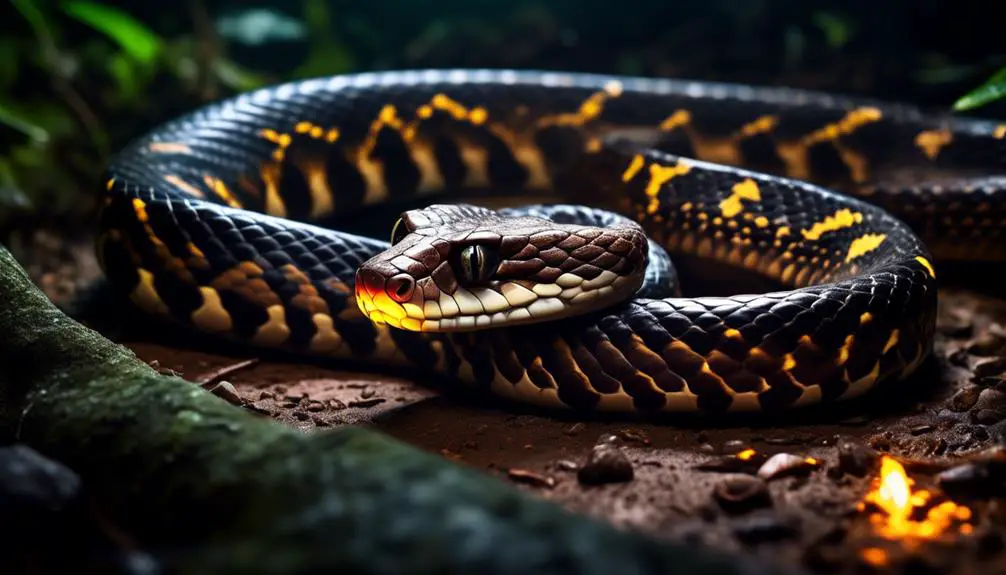Are you curious about the most frightening and dangerous animals in Puerto Rico? You may have heard rumors about the island being home to some truly menacing creatures, but is there any truth to these claims?
Well, prepare to be both fascinated and unnerved as we uncover the reality behind Puerto Rico’s natural inhabitants. From venomous spiders and scorpions to sharks and snakes, this captivating discussion will shed light on the hidden dangers that lurk within Puerto Rico’s diverse ecosystems.
So, if you’re ready to explore the dark and untamed side of this tropical paradise, join us as we embark on a journey to uncover the most terrifying creatures that call Puerto Rico their home.
Giant Centipede
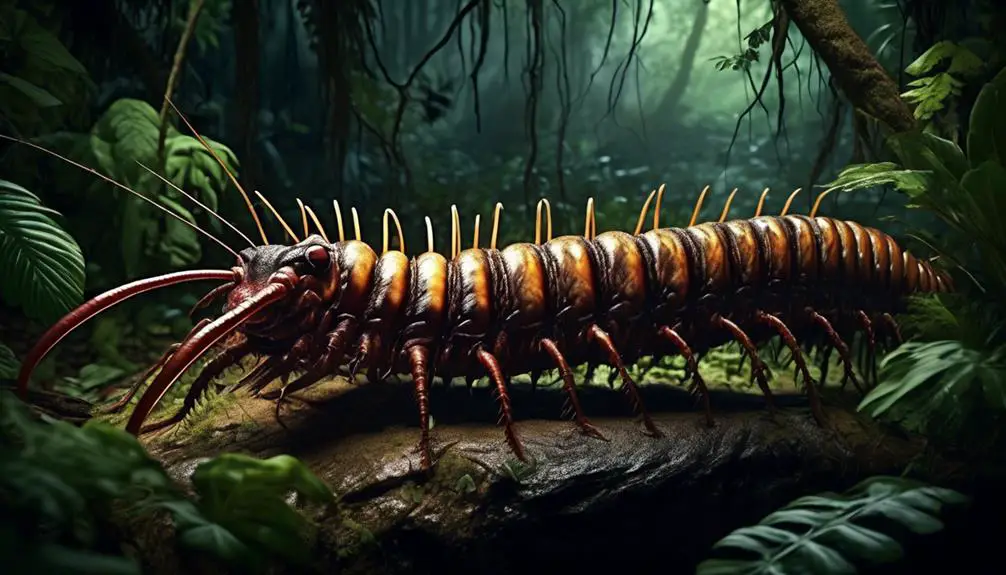
The Giant Centipede, also known as Scolopendra gigantea, is a highly dangerous arthropod found in the wooded and forested areas of Puerto Rico. This species is considered one of the most dangerous animals on the island. Its bite is extremely painful, causing intense burning sensations. However, it’s important to note that while the bite is excruciating, it’s usually not fatal to humans.
Giant Centipedes are mostly encountered in forests and mountainous regions of Puerto Rico. They’re fast-moving predators, capable of capturing and immobilizing their prey with their powerful jaws and venomous fangs. Their venom contains a potent cocktail of toxins that helps them subdue their victims.
When encountering a Giant Centipede, it’s important to exercise caution and avoid provoking them. These arthropods can deliver a painful bite if threatened or cornered. If bitten, it’s recommended to seek medical attention immediately, as the bite can cause severe pain and may require medical treatment.
Spiders
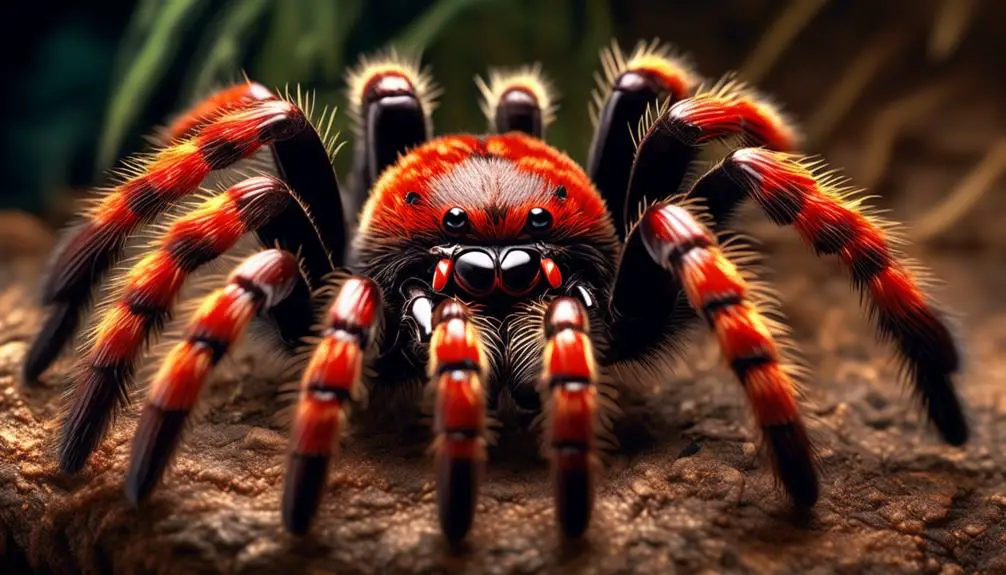
Found in Puerto Rico, spiders are a diverse group of arachnids that inhabit various habitats across the island. While some spiders in Puerto Rico are harmless, there are a few species that can be dangerous to humans. Here is a table highlighting the different types of spiders and their potential risks:
| Spider Name | Venom | Risk to Humans |
|---|---|---|
| Brown Recluse | Potentially deadly | Can cause necrotic skin lesions |
| Black Widow | Potentially deadly | Rarely bites humans |
| Puerto Rican Brown Tarantula | Harmless | Bites are not dangerous |
| Banana Spider | Not dangerous | Bites are painful but not harmful |
| Cave Spider | Harmless | No risk to humans |
The brown recluse spider is the most dangerous spider in Puerto Rico, with its venom potentially causing necrotic skin lesions. While the black widow’s venom is also potentially deadly, it rarely bites humans. On the other hand, the common Puerto Rican brown tarantula and the cave spider are harmless to humans. While the bites of the banana spider can be painful, they are not dangerous. It’s important to note that encountering these spiders is relatively rare, but caution should be exercised when exploring their habitats.
Scorpions
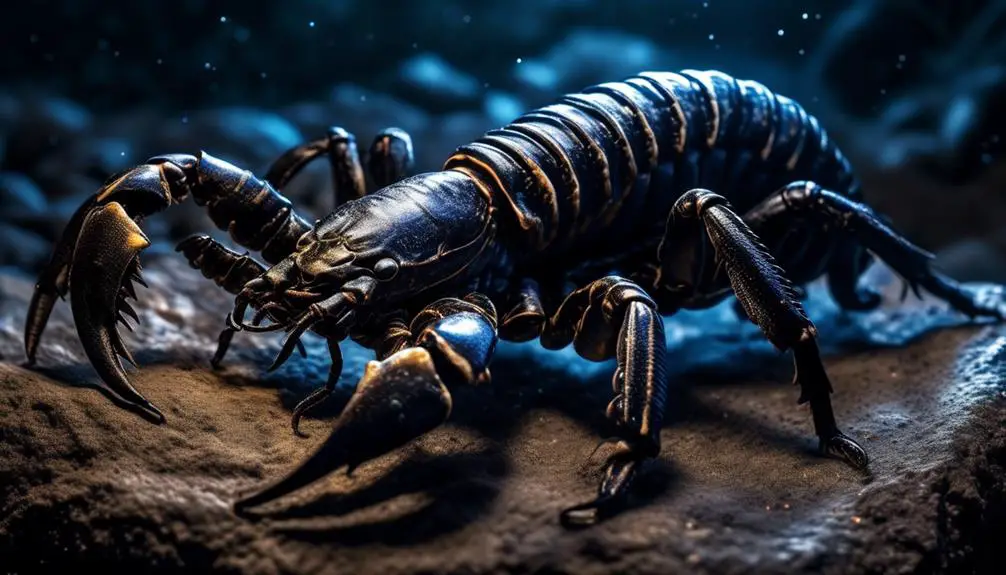
Scorpions, known for their venomous stings, can be found in Puerto Rico. The island is home to seven species of scorpions, with the Tityus scorpions being the most common. While their stings can be painful, they’re rarely deadly. However, the bark scorpion, another species found in Puerto Rico, is more dangerous and may require antivenom treatment.
Scorpions can be encountered in various places, including hotel rooms and the wild. It’s important to exercise caution to avoid painful stings. When staying in hotels, it’s recommended to check sheets and clothes before use. In the wild, it’s advisable to wear protective clothing and shoes, and to avoid reaching into crevices or under rocks where scorpions may be hiding.
If you’re stung by a scorpion, it’s essential to seek medical attention. While most scorpion stings cause only localized pain and swelling, some individuals may have severe allergic reactions. Symptoms can include difficulty breathing, muscle twitching, or numbness. It’s crucial to provide medical professionals with information about the species of scorpion involved in the sting, as this can help guide appropriate treatment.
Sharks

Sharks, known for their presence in Puerto Rican waters, encompass a diverse range of species. While fatal shark incidents are rare, it is important to stay informed and cautious when enjoying the beautiful beaches and waters of Puerto Rico. Below is a table highlighting some of the sharks that can be found in Puerto Rican waters:
| Species | Description | Potential Danger |
|---|---|---|
| Nurse Shark | Bottom-dwelling, docile sharks | Low |
| Caribbean Reef Shark | Curious and social sharks | Low to Moderate |
| Lemon Shark | Powerful and territorial sharks | Low to Moderate |
| Tiger Shark | Large and aggressive sharks | Moderate to High |
| Bull Shark | Highly adaptable and aggressive sharks | High |
| Great White Shark | One of the most aggressive shark species | High (Encounters unlikely) |
It is important to note that most sharks are not dangerous and do not pose a threat to humans. However, encounters with more aggressive species like the Bull Shark and the Great White Shark are less likely. Regularly checking for shark alerts and following safety guidelines while swimming or engaging in water activities is recommended. Remember, respecting the natural habitat of these majestic creatures is key to maintaining a harmonious coexistence.
Snakes
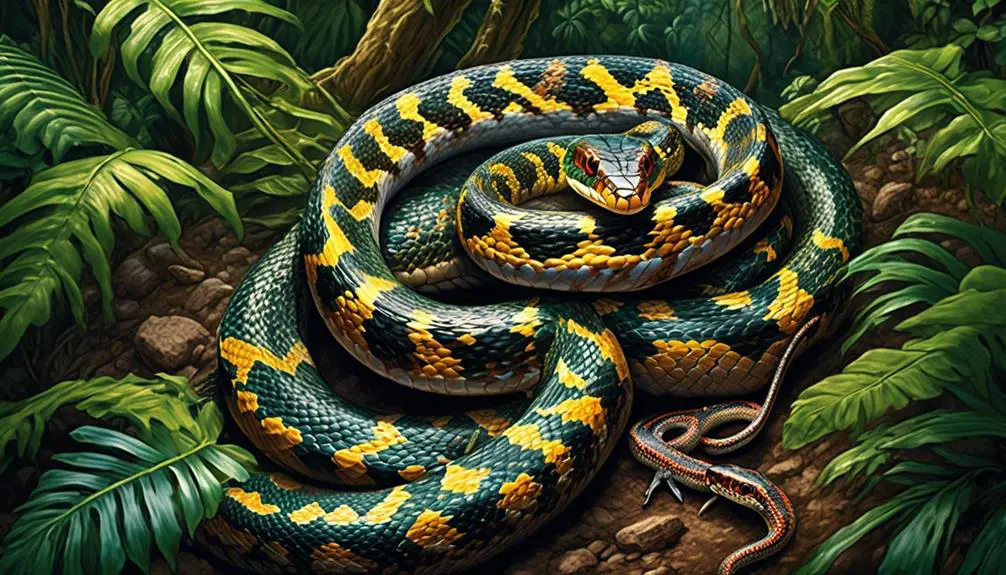
Snakes, though relatively uncommon in Puerto Rico, are an important aspect of the island’s wildlife that should be approached with caution and respect. There are approximately ten snake species found in Puerto Rico, with only one being venomous, known as the Puerto Rican racer.
The venom of the racer isn’t deadly but can cause symptoms in humans, making it important to exercise caution while encountering these snakes. The Puerto Rican racer is mainly found in Toro Negro State Forest and El Yunque Rainforest, making these areas potential habitats for snake encounters.
However, it’s unlikely to get bitten by a snake in Puerto Rico, as they generally avoid human contact. Nevertheless, while hiking in these areas, it’s advisable to be vigilant and watch out for snakes, as well as to stay on designated trails.
Lionfish
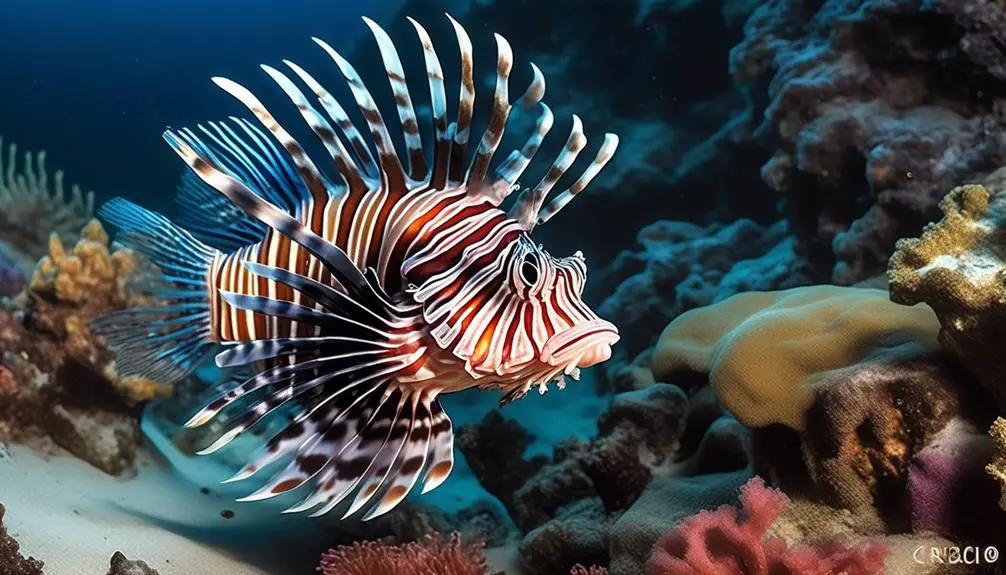
While snakes are relatively uncommon in Puerto Rico, another fascinating and potentially dangerous creature found in the waters surrounding the island is the lionfish. The lionfish, scientifically known as Pterois, is a small, colorful fish with venomous fin rays. The most common type of lionfish found in Puerto Rico is the red lionfish. Although not native to the Caribbean Sea, they’ve become invasive and are now a significant concern for the local marine ecosystem.
Lionfish have a unique defense mechanism of long, venomous spines that cover their bodies. These spines, when touched, can deliver a painful sting. The venom of the lionfish contains a mixture of neurotoxins, which can cause symptoms such as intense pain, swelling, and nausea. In rare cases, the sting can lead to more severe reactions, such as difficulty breathing or even cardiac distress.
It is important to avoid touching lionfish if encountered while swimming or diving. Their vibrant colors may be captivating, but it’s crucial to remember that these fish should be observed from a safe distance. If stung by a lionfish, it’s advisable to seek medical attention promptly. Proper treatment can help alleviate the pain and prevent any complications that may arise from the venomous sting.
Efforts are being made to control the lionfish population in Puerto Rican waters to mitigate their impact on the local marine life. Public awareness and responsible fishing practices are essential to prevent further spread and ensure the preservation of the island’s delicate ecosystem.
Mosquitos
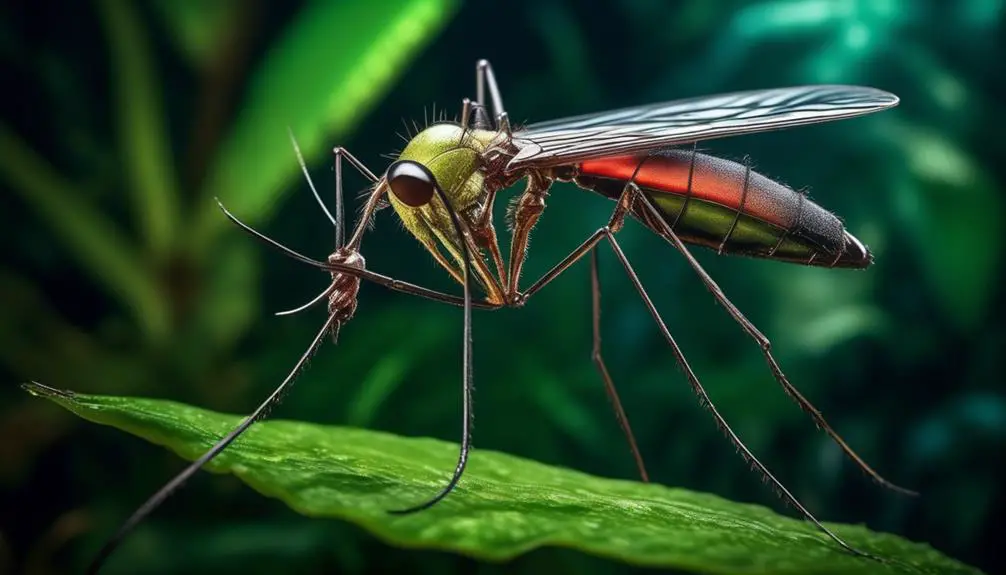
Mosquitos in Puerto Rico pose a significant risk of disease transmission due to the high population and prevalence of serious illnesses such as Zika, dengue fever, and chikungunya. These diseases may require hospital treatment and can have serious health implications.
It’s important to take precautions to avoid mosquito bites and protect yourself from these potentially harmful diseases.
Disease Transmission Risks
Mosquitoes in Puerto Rico pose a significant risk of transmitting serious diseases, including Zika, dengue fever, and chikungunya. These diseases are prevalent on the island due to the high number of mosquitoes present.
Mosquito bites can be more than just irritating; they can lead to hospital treatment and long-term health complications. Zika virus, transmitted primarily through the Aedes mosquito, can cause birth defects in pregnant women and neurological complications in adults.
Dengue fever, also transmitted by the Aedes mosquito, causes high fever, severe headache, and joint pain. Chikungunya, transmitted by the same mosquito, results in fever, joint pain, and rash.
To protect yourself from these diseases, it’s important to use mosquito repellent, wear long sleeves and pants, and eliminate standing water where mosquitoes breed.
High Mosquito Population
The high population of mosquitoes in Puerto Rico presents a significant concern for the transmission of serious diseases. Mosquitoes are known vectors for diseases such as Zika, dengue fever, and chikungunya. These diseases can cause severe symptoms and may require hospital treatment. It is important to take precautions to avoid mosquito bites, especially during peak mosquito activity times, such as dawn and dusk. Wearing long sleeves and pants, using insect repellent, and staying in screened or air-conditioned areas can help reduce the risk of mosquito bites. Below is a table highlighting some of the diseases transmitted by mosquitoes in Puerto Rico:
| Disease | Symptoms | Treatment |
|---|---|---|
| Zika | Fever, rash, joint pain, conjunctivitis | Supportive care, rest, fluids |
| Dengue fever | High fever, severe headache, joint pain | Supportive care, rest, fluids |
| Chikungunya | Fever, joint pain, muscle pain | Supportive care, rest, fluids, pain relievers |
It is essential to stay informed about mosquito-borne diseases and take necessary precautions to protect yourself from these potentially harmful insects.
Serious Health Implications
With the high population of mosquitoes in Puerto Rico and their potential to transmit serious diseases, understanding the serious health implications associated with these insects is crucial.
Mosquitoes in Puerto Rico can transmit diseases such as Zika, dengue fever, and chikungunya. These diseases are prevalent on the island due to the high number of mosquitoes. The symptoms of these diseases can range from mild to severe and may require hospital treatment.
Additionally, mosquito bites can be more than just irritating. They can lead to serious health complications, especially for individuals with weakened immune systems or pre-existing health conditions.
Therefore, it’s important to take preventive measures such as using mosquito repellents, wearing protective clothing, and eliminating standing water to reduce the risk of mosquito-borne diseases.
Caimans
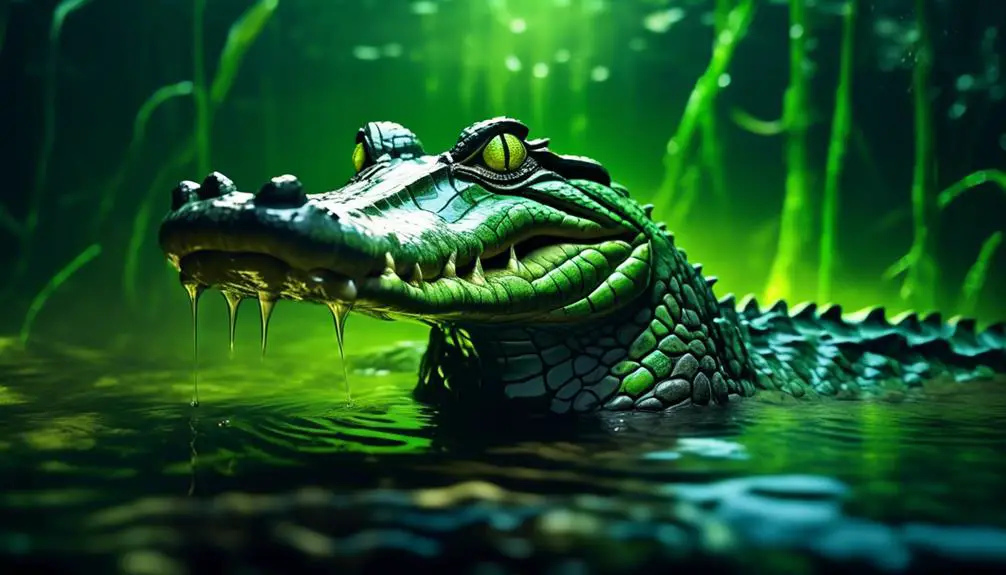
Caimans, small crocodile-like reptiles, are found in freshwater habitats in Puerto Rico. They’re generally not aggressive towards humans but can bite if provoked or cornered.
When encountering a caiman in the wild, it’s important to keep a safe distance to avoid any potential threats.
Habitat and Behavior
In their natural habitat, caimans can be found in freshwater habitats throughout Puerto Rico. These small crocodile-like reptiles are generally not aggressive towards humans, but they can bite if provoked or cornered.
Caimans have a unique set of behaviors that allow them to thrive in their environment. They’re excellent swimmers, using their powerful tails to navigate through the water with ease. Caimans are also skilled hunters, using their sharp teeth to catch and consume their prey, which mainly consists of fish, birds, and small mammals.
They’re primarily nocturnal, meaning they’re most active during the night, and they tend to spend their days basking in the sun or hiding in vegetation along the water’s edge.
If you encounter a caiman in the wild, it’s important to keep a safe distance and avoid any actions that may provoke an attack.
Potential Threats
As we shift our focus to the potential threats posed by caimans in Puerto Rico, it is important to understand the risks associated with encountering these small crocodile-like reptiles in their natural habitat. Caimans are generally not aggressive towards humans but can bite if provoked or cornered. If you come across a caiman in the wild, it is crucial to keep a safe distance to avoid any potential danger. To provide a clearer understanding of the potential threats, refer to the table below:
| Potential Threats of Caimans | Risks |
|---|---|
| Biting if provoked or cornered | Physical injury |
| Potential transmission of bacteria or infections through bites | Infection or disease |
| Possible damage to property or belongings | Property loss or damage |
| Increased risk of encounters near bodies of freshwater | Higher likelihood of interactions |
| Limited visibility in certain habitats | Difficulty in spotting and avoiding caimans |
It is crucial to exercise caution and respect when encountering caimans in Puerto Rico to ensure personal safety and the well-being of these reptiles.
Safety Tips
To ensure your safety when encountering caimans in Puerto Rico, it’s important to follow these safety tips.
Firstly, it’s crucial to keep a safe distance if you come across a caiman in the wild. While caimans are generally not aggressive towards humans, they can bite if provoked or cornered. It’s best to observe them from a distance and avoid any sudden movements or loud noises that may startle them.
Additionally, don’t attempt to feed or touch caimans as they may interpret it as a threat and respond defensively.
If you encounter a caiman in a residential area or near a swimming spot, it’s recommended to notify local authorities or wildlife officials for assistance.
Box Jellyfish
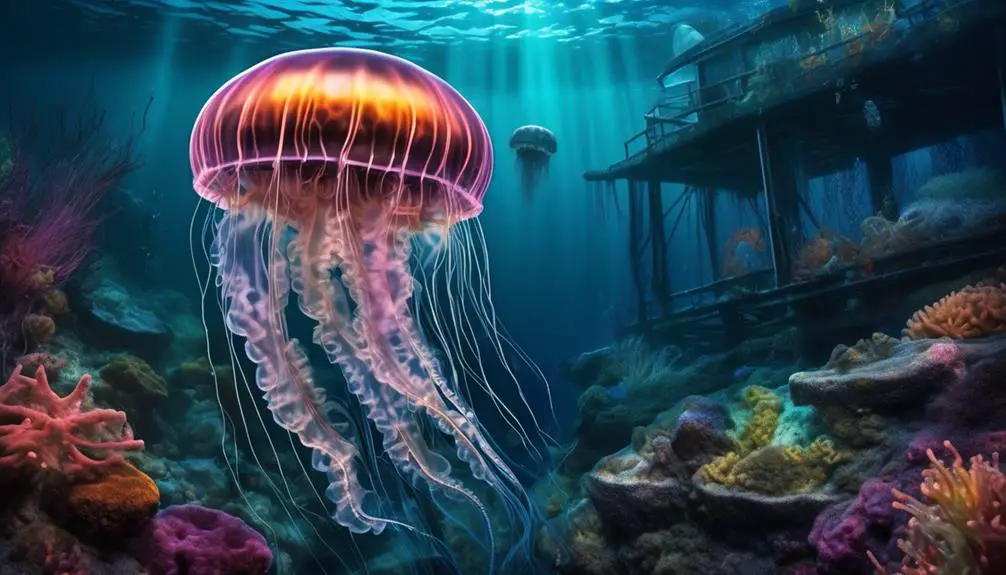
Box jellyfish, dangerous marine creatures found in the waters around Puerto Rico, possess tentacles with venomous cells that can cause severe pain. These jellyfish are known for their distinctive box-shaped bell and long, trailing tentacles. The venomous cells, called nematocysts, are found on the tentacles and are used by the jellyfish to capture prey and defend themselves.
The sting of a box jellyfish can be excruciatingly painful and can cause a range of symptoms. The venom can lead to skin redness, swelling, and blistering at the site of the sting. In some cases, the pain can radiate to other parts of the body and may be accompanied by muscle cramps and spasms. Severe reactions can include difficulty breathing, chest pain, and even heart problems.
If you’re stung by a box jellyfish, it’s important to seek medical attention immediately. While there’s no specific antidote for box jellyfish stings, medical professionals can provide supportive care to manage the symptoms and prevent complications.
To avoid encounters with box jellyfish, it’s best to be cautious when swimming or snorkeling in areas where they’re known to inhabit. Pay attention to any warning signs or advisories from local authorities. Wearing protective clothing, such as a wetsuit or rash guard, can also help reduce the risk of being stung.
Tarantulas
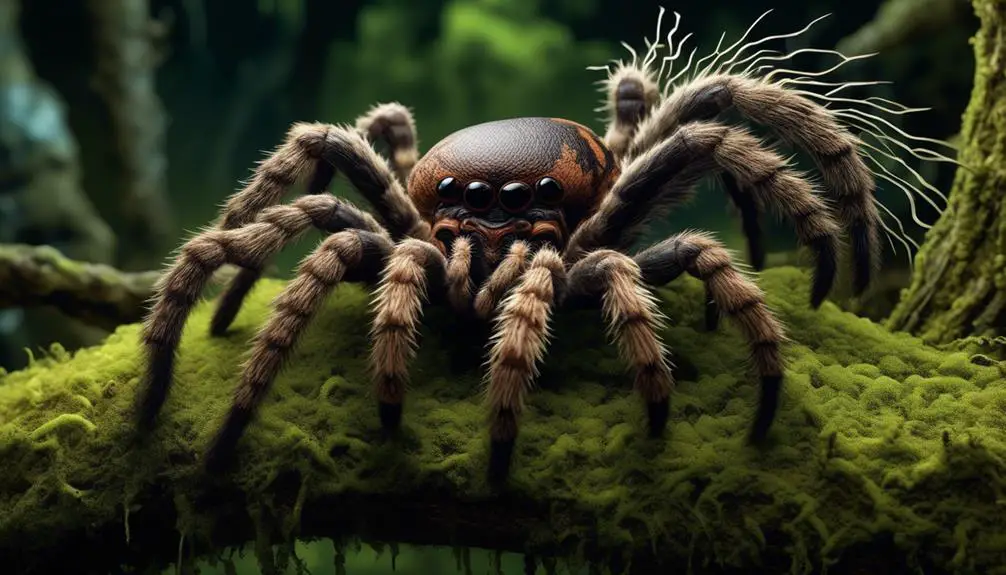
Tarantulas are a fascinating species of spider found in Puerto Rico. Despite their intimidating appearance, most tarantulas in Puerto Rico are harmless to humans. Their bites may cause some discomfort, but they aren’t venomous and don’t pose a significant danger.
Harmless Tarantula Species
The harmless tarantula species found in Puerto Rico are known for their docile nature and pose no threat to humans. These fascinating arachnids are often misunderstood and feared due to their appearance, but they play an important role in maintaining the ecosystem. Here are three examples of harmless tarantula species commonly found in Puerto Rico:
| Species | Appearance |
|---|---|
| Avicularia versicolor | Vibrant colors, including blue, purple, and pink |
| Brachypelma vagans | Black body with red hairs on the abdomen |
| Grammostola rosea | Light brown or tan color with a pinkish hue |
These tarantulas primarily reside in forests and grasslands, where they build burrows or create silk-lined retreats. They feed on insects, small vertebrates, and occasionally plants. Despite their intimidating appearance, these tarantulas are generally calm and will only bite if provoked or threatened. Their bites are non-venomous and cause minimal pain, similar to a bee sting. If you encounter one of these harmless tarantulas in Puerto Rico, it’s best to observe them from a safe distance and appreciate their beauty and role in the environment.
Tarantula Bite Effects
While harmless tarantulas found in Puerto Rico may not pose a threat to humans, it’s important to understand the potential effects of a tarantula bite. Tarantulas are known for their large size and intimidating appearance, but their bites are generally not harmful to humans.
When a tarantula bites, it injects venom into its prey to immobilize and digest it. However, the venom of most tarantulas isn’t potent enough to cause significant harm to humans. In fact, the majority of tarantula bites result in only minor symptoms such as pain, redness, and swelling at the site of the bite.
Some individuals may experience allergic reactions, characterized by itching, rash, or difficulty breathing. It’s important to note that severe reactions to tarantula bites are extremely rare.
If you’re bitten by a tarantula, it’s recommended to clean the wound thoroughly and apply an antiseptic to prevent infection. If symptoms worsen or persist, seeking medical attention is advised.
Black Widow
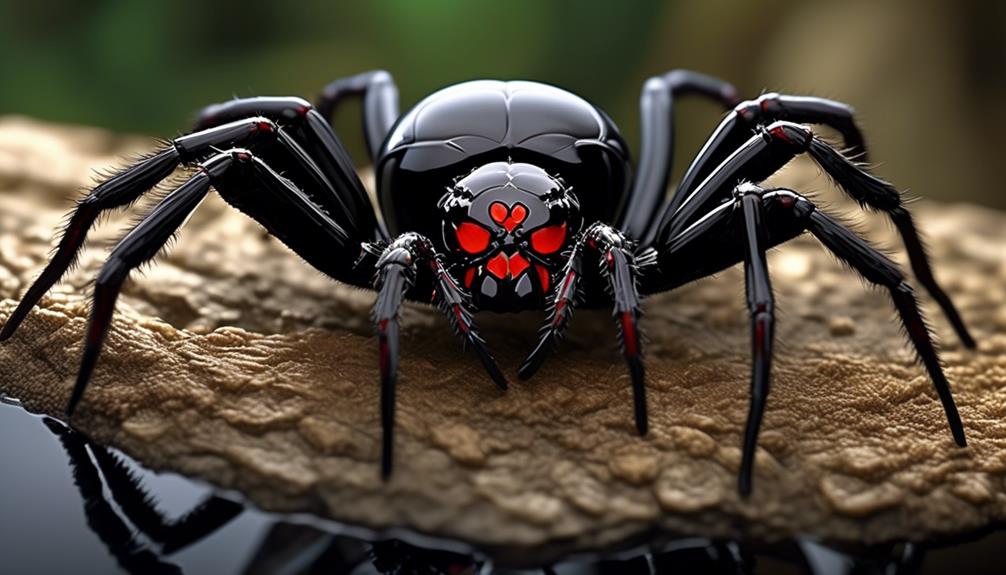
Black widow spiders, known for their potentially deadly venom, are a species to be cautious of in Puerto Rico. These spiders belong to the Latrodectus genus and are identified by their black bodies and red hourglass-shaped markings on their abdomens. Although black widows are not aggressive and typically avoid humans, their venom can cause severe symptoms and even death in some cases. It is important to exercise caution and take appropriate measures to avoid encounters with these spiders.
| Black Widow | |
|---|---|
| Characteristics | Black body with red hourglass-shaped markings on abdomen |
| Behavior | Non-aggressive, generally avoids human contact |
| Venom | Potentially deadly, contains neurotoxins that affect the nervous system |
| Symptoms | Intense pain, muscle cramps, nausea, vomiting, sweating |
| Treatment | Seek medical attention immediately, administer antivenom if necessary |
If you come across a black widow spider, it is best to leave it undisturbed and contact local authorities or pest control experts for removal. It is also important to educate yourself and others about the appearance and behavior of black widows to minimize the risk of accidental encounters. Remember, prevention is key when it comes to dealing with potentially dangerous animals like black widow spiders in Puerto Rico.
Bark Scorpion
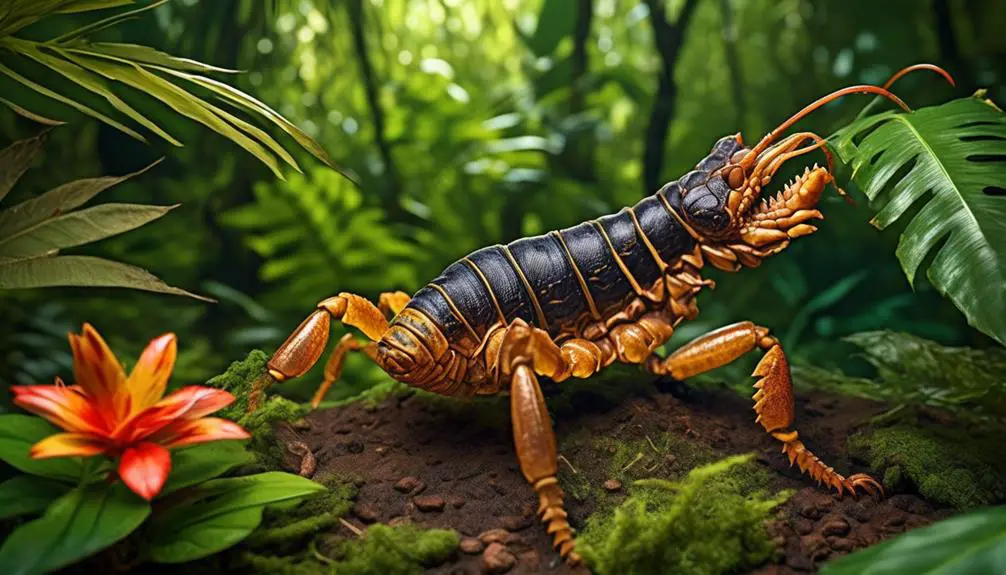
After discussing the potential dangers of encountering black widow spiders in Puerto Rico, it’s important to shift our attention to another potentially harmful creature found on the island – the bark scorpion.
The bark scorpion, scientifically known as Centruroides exilicauda, is a species of scorpion that can be found in Puerto Rico. This particular scorpion is known for its yellowish-brown coloration and small size, typically measuring around 2 to 3 inches in length. Despite its small size, the bark scorpion possesses venom that can cause severe pain and discomfort if a person is stung. It’s important to note that while most bark scorpion stings aren’t life-threatening, some individuals may have allergic reactions that require medical attention.
To avoid encounters with bark scorpions, it’s recommended to be cautious when exploring outdoor areas, especially at night when these nocturnal creatures are most active. When in areas where bark scorpions are known to reside, it’s advisable to wear protective clothing, such as long sleeves and pants, and to shake out any clothing or shoes before putting them on. Additionally, taking precautionary measures such as inspecting sleeping areas and keeping them clean can help minimize the risk of a bark scorpion sting.
Puerto Rican Racer
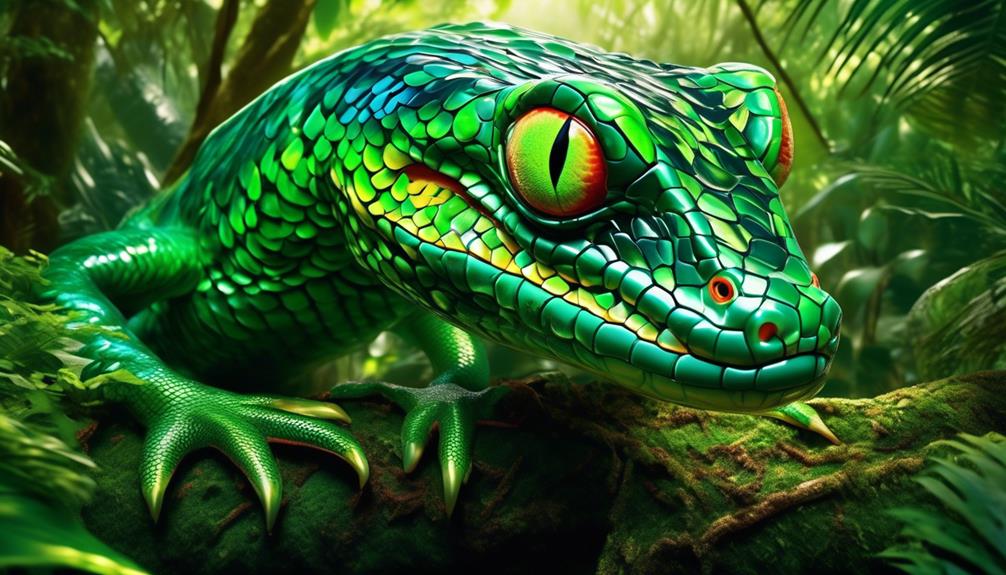
The Puerto Rican Racer, scientifically known as Alsophis portoricensis, is a non-venomous snake species native to Puerto Rico. It’s one of the approximately ten snake species found on the island. Unlike other snakes in Puerto Rico, the Puerto Rican Racer doesn’t possess venom.
This species can be found mainly in Toro Negro State Forest and El Yunque Rainforest. Although encounters with this snake are unlikely, caution is advised while hiking in these areas.
The Puerto Rican Racer is slender and can grow up to 4 feet in length. It has a distinct pattern of dark scales with light, yellowish bands running across its body. While the bite of the Puerto Rican Racer isn’t deadly, it can cause symptoms such as pain, swelling, and redness.
It’s important to remember that snakes play a crucial role in the ecosystem and shouldn’t be harmed. Instead, it’s recommended to maintain a safe distance and appreciate these fascinating creatures from afar.

Erzsebet Frey (Eli Frey) is an ecologist and online entrepreneur with a Master of Science in Ecology from the University of Belgrade. Originally from Serbia, she has lived in Sri Lanka since 2017. Eli has worked internationally in countries like Oman, Brazil, Germany, and Sri Lanka. In 2018, she expanded into SEO and blogging, completing courses from UC Davis and Edinburgh. Eli has founded multiple websites focused on biology, ecology, environmental science, sustainable and simple living, and outdoor activities. She enjoys creating nature and simple living videos on YouTube and participates in speleology, diving, and hiking.

